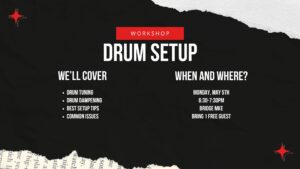You don’t need to scream your way into rock history. The best rock vocalists don’t shred their vocal cords—they master them. Whether you’re drawn to the electrifying power of Chris Cornell, the raw rasp of Janis Joplin, or the grunge-soaked growl of Kurt Cobain, one thing is true: the voice is an instrument. And like any instrument, it can be played with skill or abused until it breaks.
I remember one of our first students—let’s call him Jake. He wanted to sound like Axl Rose, but after a few self-taught sessions, he came into the studio barely able to talk. His voice was fried from trying to imitate grit by sheer force. Within a month of guided practice and the right techniques, he was belting high notes with grit and control, without a hint of pain. That’s what this guide is about: learning to sing rock with power and edge, without torching your voice in the process.
1. Understanding Rock Vocal Styles
Rock is not one-size-fits-all. From the silky scream of Steven Tyler to the haunting whisper-growl of Billie Eilish’s darker tracks, every rock voice is unique. Before you even open your mouth, take a second to ask yourself: what kind of rock singer do you want to be?
Power and grit aren’t the same. Power is projection and presence—the ability to cut through the mix. Grit is texture, like a layer of sonic rust that adds edge and attitude. Some singers, like Freddie Mercury, achieve massive presence with clean, soaring vocals. Others, like Dave Grohl, bring in controlled rasp that feels like gravel under tires.
Your voice has its own fingerprint, and learning how to shape it starts with understanding these differences.
Mini Exercise: Make a playlist of five rock vocalists you admire. Listen closely. What do they do that moves you? Is it raw emotion, clarity, edge, or all of the above? This will help guide your stylistic goals.
2. The Foundations of Safe Rock Singing
Before you punch in the distortion pedal, you need a solid clean tone. Your body is the amp. If your breath support is weak and your posture is collapsing, adding grit is like throwing nitro on a campfire.
One of the first things we teach is breath support. Imagine blowing up a balloon. The air comes from your belly, not your throat. That’s breath control. Combine that with simple warmups—lip trills, humming scales, and even singing through a straw in a cup of water—and you’re building the kind of vocal resilience that lets you rock all night without burning out.
Jake, the student I mentioned earlier, couldn’t believe how much easier singing got after two weeks of proper breath work. He thought power came from the neck up—tight jaw, clenched throat, pushed chest. Turns out, once he got his posture and breath aligned, everything opened up.
Key Techniques to Master First:
-
Diaphragmatic breathing
-
Lip trills and straw phonation
-
Body alignment and neck/jaw relaxation
Quick Tip: Warm up before and cool down after singing. Your voice is a muscle. You wouldn’t bench press without stretching first, right?
3. How to Add Power Without Strain
Power isn’t about shouting. It’s about controlled energy. Think of it like a pressure washer—the water doesn’t explode out of the hose, it’s focused through a narrow point, creating force without chaos.
This is where compression comes in—a vocal technique that uses resonance and twang to amplify your sound. Twang is that bright, edgy tone that cuts through noise without raising the volume. Ever hear a country singer belt over a band without even seeming to try? That’s twang in action.
When teaching this, I have students say a witchy “Nyaaah!” like they’re casting a spell. It’s silly, but it works. That brightness adds clarity and punch to your tone, making it sound bigger without you needing to push harder.
Keys to Powerful Singing:
Use breath support and forward resonance (feel it in your nose and cheeks)
Explore vocal twang and mask placement
Don’t oversing—let the mic do its job
Watch Out For: Throat tension, especially when you’re trying to get loud. If you feel pressure in your neck instead of your gut or face, reset.
4. Techniques for Adding Grit Without Damage
Adding grit is like adding spice to a dish. Too little and it’s bland. Too much, and you can’t taste anything else—and your vocal cords will regret it.
Controlled grit uses specific techniques like false cord distortion and vocal fry. These sound intense but can be safe when done properly. Compare it to riding a motorcycle: thrilling, powerful, but you better know how to handle it.
When introducing grit, we have students start with vocal fry—the creaky, low rumble you make when you say “huhhh” with no energy. Then we build intensity from there, always with strong breath support. Never add grit on top of a weak foundation.
Practical Exercises:
Vocal fry at low volume (focus on gentle onset)
Add grit only on the end of phrases at first
Record yourself and check for consistency (not strain)
Warning Signs: If you feel pain or lose your voice, stop. No rock show is worth vocal nodules.
5. Common Mistakes and How to Avoid Them
Mistake #1? Thinking grit equals shouting.
Mistake #2? Skipping warmups.
Mistake #3? Believing pain means progress.
I’ve seen singers hit the stage hot and confident, only to limp away with no voice and a week of silence ahead. Most of these issues are preventable.
Here’s a checklist to keep your voice in the game:
Are you warming up? (5–10 min minimum)
Do you feel throat tension? (That’s a red flag)
Are you practicing regularly or just at rehearsals? (Consistency matters)
Are you recording and reviewing yourself? (Self-awareness leads to improvement)
Bonus Tip: Hydrate. Every. Day. Not just right before you sing.
Conclusion
Rock vocals are about energy, identity, and attitude—but your voice has to survive the ride. By learning the right techniques, warming up properly, and adding grit with intention, you can sound fierce without hurting yourself.
Whether you’re jamming with friends or headlining your local venue, the goal is the same: sing hard, sing smart, and let your voice carry the story you’re meant to tell.
So go ahead—turn up the volume, channel your inner rock god, and let it rip. Just make sure your technique is as solid as your passion.
More Blogs

Rhythm Guitar Mastery: Strumming and Riff Techniques for Pop and Country
You know that feeling when a song just clicks — when the beat feels like it’s syncing with your heartbeat, and the chords seem to

Home Recording on a Budget: Recording Your Practice Sessions
You’ve been working hard on your music—nailing that tricky chord change, perfecting your drum fills, polishing your vocals. But how do you really know if

Drum Setup Workshop
Drum Setup Workshop We are announcing our next upcoming workshop! Many drummers struggle with tuning and best setup practices. With so many variables and no